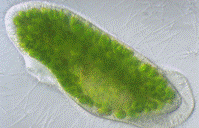Insect limitation of weedy plants and its ecological implications.

The ecological consequences of releasing a genetically modified organism into a novel environment will depend upon its establishment, dispersal, and interactions with other organisms. Establishment and dispersal in the population dynamics of weedy plants are discussed by Jordan (these proceedings). My task is to discuss the known effects of plant-feeding insects on populations of native weedy plants, which provide the best current predictive basis for assessing the potential ecological consequences of the movement of resistance genes from genetically modified crops into their native weedy relatives.
The focus of our research over the last 20 years has been on understanding and predicting the quantitative outcome of plant-feeding by insects on the density, distribution, and lifetime reproductive success of native weedy plants. In the context of this workshop, these data can be used to address: (1) what is the evidence that insect herbivores can limit plant population density, restrict plant distribution, or reduce lifetime reproduction of native weedy plants? (2) under what circumstances is such limitation strongest or most likely? and, (3) when might increased resistance to insects alter the weed status of presently innocuous weedy plants?
Experimental evidence that feeding by insect herbivores can influence the growth, reproduction, and population density of native herbaceous plants has accumulated over the last 25 years (see reviews: Crawley 1983, 1997; Parker 1985; Hendrix 1988; Weis and Berenbaum 1989; Louda 1989, 1995). From these studies it is clear that herbivorous insects, either singly or in combination, often significantly limit both the success of individual plants and the densities of populations of native weedy plants. Increased insect resistance in such cases would result in a reduction in control exerted by insects on plants and would lead to a prediction of increased weediness of the native plant species.
To illustrate the influence of insects on plants and to explore the circumstances under which insect herbivores have been shown to be crucial in limiting plant density, I would like to review the highlights of two of our research projects. The first concerns a native crucifer that is related to canola and wild radish (Brassicaceae). The second project concerns a group of native thistles that are related to sunflower (Asteraceae). In addition, I will review some of the implications of these data for anticipating potential ecological responses to altered insect pest resistance introduced into related weedy native plants. In the absence of direct tests on the role of insects in the dynamics of crop-related weedy native species, these studies can be used as the best models presently available to assess the role of insects and insect resistance in the dynamics of native weed populations.
Go here https://steemit.com/@a-a-a to get your post resteemed to over 72,000 followers.